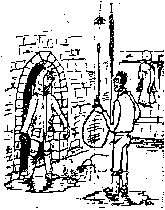The Tower Handbook
5.2 Effects of weather?
a: Why do ropes sometimes seem shorter than others?
Traditional ropes are made of hemp or flax. In humid air natural fibres absorb moisture and swell. It makes the rope a bit fatter and a bit shorter. You don't notice the rope being 1% thicker (about 5 thousandths of an inch) but 1% of a 20 foot rope length is a couple of inches. A 'non stretch' rope has a pre-stretched polyester (Terylene [30]) top end. As well as being less stretchy, the synthetic fibres do not absorb moisture like natural fibres, so the length hardly changes as the air changes from dry to moist. See section 14.8o.
You can also get an apparent, rather than real, lengthening of the ropes if the ringing is faster. Below the balance you need less rope length between you and the bell which means correspondingly more below your hands.
b: Why do ropes go stiff in winter?
 This is mainly to do with moisture. In the winter the air humidity is regularly high, and low temperatures do not encourage moist ropes to dry out anyway. Natural rope fibres swell when moist (see above) and as well as the length change, the swelling fibres pressing more tightly together make the rope stiff. Most bell ropes have natural fibre tail ends, even those with synthetic tops, so you are more likely to find stiff ropes than shortened ropes. If your ringing room is heated for part of the week the periodic drying will tend to reduce the effect.
This is mainly to do with moisture. In the winter the air humidity is regularly high, and low temperatures do not encourage moist ropes to dry out anyway. Natural rope fibres swell when moist (see above) and as well as the length change, the swelling fibres pressing more tightly together make the rope stiff. Most bell ropes have natural fibre tail ends, even those with synthetic tops, so you are more likely to find stiff ropes than shortened ropes. If your ringing room is heated for part of the week the periodic drying will tend to reduce the effect.
c: Why do some bells drop in cold weather?
This is an extreme problem sometimes experienced with bells hung on plain bearings. Plain bearings rely on lubrication, much more than ball bearings do. Designing a lubricant is a compromise. It needs to be thick enough to withstand the forces on the bearing and keep the metal surfaces apart, but it must be thin enough to flow into the bearing as required. Unfortunately, as lubricants get colder they become thicker and work less effectively.
d: Do bells left up in winter fill with snow?
In a strong wind, snow blows through the louvres and swirls round the bell chamber, though not usually a lot. If the bells are up, some will settle inside where the air is stiller. When the bells are pulled off it is thrown out. If it is powdery it floats in the air and a few crystals come down the through rope holes to sprinkle on the ringers' hands.
e: Does it only happen at Christmas?
Towers which normally leave their bells down often leave them up over night between Christmas Eve and Christmas Day, so the only time ringers at such towers are likely to feel snow crystals on their hands is as they pull off on Christmas morning (if it snowed on Christmas Eve).
f: Why are bells in wooden towers harder to ring in summer?
In extended dry weather timber dries out and shrinks very slightly. This shrinkage allows joints to become looser. A wooden tower is effectively a very tall bell frame with cladding on the outside. Its rigidity relies on the joints between the many cross braces etc being tight. If they loosen in dry weather, the tower moves as the bells swing, and this makes them harder to ring. Individual bells will drop or rise depending on whether the tower happens to be moving in sympathy with them or against them, see below.
Stone towers with wooden frames often have a similar problem but it is less severe than in a wooden tower.
Previous

 Next
Next
Currently hosted on jaharrison.me.uk
 This is mainly to do with moisture. In the winter the air humidity is regularly high, and low temperatures do not encourage moist ropes to dry out anyway. Natural rope fibres swell when moist (see above) and as well as the length change, the swelling fibres pressing more tightly together make the rope stiff. Most bell ropes have natural fibre tail ends, even those with synthetic tops, so you are more likely to find stiff ropes than shortened ropes. If your ringing room is heated for part of the week the periodic drying will tend to reduce the effect.
This is mainly to do with moisture. In the winter the air humidity is regularly high, and low temperatures do not encourage moist ropes to dry out anyway. Natural rope fibres swell when moist (see above) and as well as the length change, the swelling fibres pressing more tightly together make the rope stiff. Most bell ropes have natural fibre tail ends, even those with synthetic tops, so you are more likely to find stiff ropes than shortened ropes. If your ringing room is heated for part of the week the periodic drying will tend to reduce the effect.